The advantage of aquatic plants for fish species diversity and biomass is well documented from numerous temperate, subtropical and tropical water bodies. An increasing number of detailed field studies is being supported by controlled field and laboratory experiments which allow to better understand the often complicated relationships of water quality, primary algal production, zooplankton, micro- and macrobenthos, periphyton, aquatic macrophytes and fish. Regulation of aquatic macrophytes can be executed through interference with most of the individual links within the web of the interrelationships, such as for example nutrient concentration, periphyton, zooplankton, macroinvertebrates (e.g. crayfish), or the individual species of fish and aquatic macrophyte communities. Some of the knowledge has been applied in the biomanipulation approach to improving water quality in shallow eutrophic lakes of the temperate zone. Manipulation of aquatic plants has led to an increase in desirable sport fish, or to an overall increase in the productivity of a water body. Control of macrophytes using fish has been used in achieving higher fish production, especially in small water bodies, such as ponds and small lakes.
Occurrence in some waters of invasive aquatic macrophytes, such as Hydrilla and Myriophyllum, although not appreciated by some water users, has often led to a considerable, multifold increase in fish stocks. Floating exotic invasive plants such as Salvinia molesta and water hyacinth, if not occurring in a solid mass over large areas, have been found to also enhance fish stocks by providing shelter and feeding opportunities. In tropical waters high fish catches are achieved along the margins of lakes with floating aquatic plants, such as papyrus.
Knowledge of fish behaviour is an important factor in aquatic plant management for fishery purposes. Many fish associate with either the water surface immediately above the plants, the periphery of the dense stands, “holes” formed in the plant beds, or the bottom directly below dense canopy formations to use both open and structurally complex areas for foraging and predator avoidance (Killgore et al., 1989). In dense plants piscivorous fish may be more common at the periphery of the plant beds or in the “holes” in aquatic plants. Creation of strips of intermediate vegetation density or open lanes within the vegetation is thought to enhance the stocks of piscivores and the access of sport fishermen to these fish. Olson et al. (1998) removed aquatic plants from about 20% of the littoral zone by cutting a series of channels through each of the four investigated lakes in Wisconsin (USA). In the first year after manipulation, bluegill and largemouth bass substantially increased growth rates of some age classes. The results suggest that harvesting macrophytes in a series of deep channels may be a valuable tool for integrated management of fish and macrophytes.
On the other hand, when aquatic macrophytes occupy large areas of a water body, a reduction in the fish condition can occur, resulting in a stunted fish population (Colle and Shireman, 1980). Annual senescence of the plant community in temperate waters will result in a gradual reduction in refuge for small fish, exposing them to predators. Or, the senescence will result in the loss of epiphytic algae and associated invertebrates, leading to a decline in the condition of fish depending on this food (see Section 2.1.2).
Fishery objectives should be addressed prior to any generalised management orientation regarding aquatic vegetation control. Aquatic vegetation represents an important habitat for fish, which may use it for feeding, reproduction and escape from predators. Aquatic macrophytes also play a vital role in bringing nutrients trapped in bottom sediments back up into the aquatic environment, and the detritus generated by aquatic macrophytes may boost the production of benthic organisms.
Controlling macrophytes using grass carp enhances fish stocks of some other fish species. (See Section 3.1.2.).
A gradual or fast increase in one particular aquatic macrophyte of an invasive character can result in a threat to commercial or recreational fishery. In many lakes throughout the tropics, water hyacinth or salvinia has made commercial fishery difficult. This applies to large lakes of East Africa, reservoirs in Asia and Latin America, floodwater lakes (lagoons) in Papua New Guinea, and many other water bodies. Massive spread of the indigenous floating macrophyte Pistia stratiotes on one arm of the Volta Lake (reservoir) in Ghana has also represented an obstacle to fishery activities. Sudd and floating islands in Sudan and some other places of Africa, and varzea meadows in the Amazon Basin also hinder fisheries. In some Florida lakes invasive Hydrilla verticillata or Myriophyllum spicatum have required a management response to prevent a decline in recreational fishery. Biological control using fish has been successful only in some situations concerning submersed plants, but fish have made little impact on floating plants.
Over the last 20 years Lake Seminole, Alabama (USA) has experienced a dramatic increase in the coverage of Hydrilla verticillata, peaking at about 65% surface area in 1992. A comparison of the angling effort and total catch showed a decrease by over 36% between 1985 and 1996, and nearly all of this decline was attributable to fewer anglers seeking largemouth bass (Micropterus salmoides). In 1996, catch rates of largemouth bass greater than or equal to 305 mm total length were extremely low. Catch rates for sunfish (Lepomis spp) also decreased (Slipke et al., 1998). Interestingly enough, in a Florida lake in the presence of a coverage by 75% of Hydrilla the survival of the young pike Esox niger and some other American sport fish was higher than outside such areas (Shireman et al., 1983).
In Lake Kyoga, an important fishery water body in Uganda, mats of water hyacinth have blocked the access to numerous fish landing sites on the southern part of the lake. Along the eastern and southern shores a 10 to 15 m wide belt of water hyacinth forms a fringe along the papyrus. In 1995 four ferry crossings were also often completely blocked by this plant (Orach-Meza, 1996). Not only does this plant cause blockages, but it also swamps fish breeding sites and hinders fishing, which has been reflected in reduced catches, rising costs of operation also due to the higher consumption of fuel, lower incomes to the fishermen and higher prices to consumers. The invasion of the bays by the weed has caused fish to migrate to open waters, particularly in Lake Victoria, and has thus reduced the potential of the bays for fishing, spawning and nursing. Along the Njira beach, Kenya, water hyacinth blocked the fish landing sites. To get to the shore, the fishermen had to clear the plant manually. The plant also interfered with fishing nets set to catch Rastrienobola argentea, a small common pelagic fish, which is recorded as second in importance after the Nile perch. This fish, dried in the sun, is sold for animal and poultry feed. To get around the problem of masses of water hyacinth, some Lake Victoria fishermen started installing fish traps around the plant patches, as seen along the Yala swamp in Kenya by Thompson in 1991 (FAO, 1993a). By 1999, in Lake Victoria water hyacinth has been reported to cover already 10 000 ha, and a united strategy for fighting this problem facing the three countries sharing the lake, has yet to be found (Lindsey and Hirt, 1999). The currently dramatic reduction in water hyacinth cover as a result of biocontrol measures suggests (see Section 7), however, that an effective control measure is now available, making the formulation of future control strategies for the riparian countries much easier.
In Papua New Guinea, the explosive growth of Salvinia molesta in the late 1970s in the Sepik River lagoon system, was a major obstacle to fishing. Prior to the appearance of this plant, there was a steady growth in catches of Oreochromis mossambicus from the lagoons. It was expected that this introduced fish would form a base for a salt and smoked fish production on a relatively large scale. The expansion of Salvinia over some 250 km2 of lagoons led to a collapse of this fishery in the late 1970s. The situation improved in the early 1980s, when Salvinia was largely destroyed by the introduced beetle Cyrtobagous salviniae (Photo 20).
Further fisheries enhancement has been achieved by the introduction of a second tilapia, Tilapia rendalli, which has become well established in the lowland swamps of the Sepik-Ramu river system. In Kerala (India) backwaters, the seasonal explosive growth of Salvinia virtually stops any kind of fishing there for several months.
In the Philippines, water hyacinth has caused a major problem to netcage culture production in Laguna de Bay (see Section 7.1).
It is not the purpose of this publication to provide a comprehensive review of side-effects of the individual, most common herbicides used today to control emergent, floating or submersed aquatic macrophytes. A few examples in the following paragraphs highlight the impact on fish of the most benign for non-target organisms herbicides glyphosate and 2,4-D (used for floating and emergent plants), diquat and fluridone (used for submersed plants).
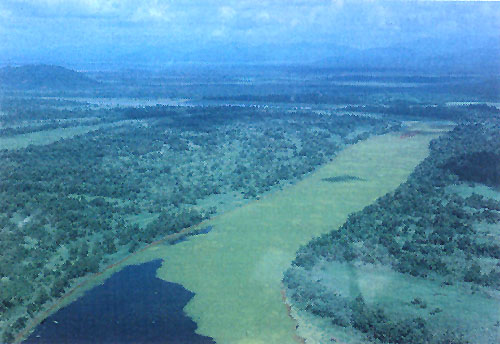
PHOTO 20: Sepik River backwater (lagoon) filled with salvinia. Note the oval patch in the far distance of the lagoon resulting from the release of Cyrtobagous salviniae. Within a year the beetle spread throughout the lagoon, eliminating all salvinia.
Glyphosate, the active ingredient of the herbicide Roundup, has been cleared by the World Health Organisation for safe use in or near watercourses, being virtually non-toxic. Trials in Ireland have demonstrated the capacity of glyphosate to remove obstructive stands of reeds (mainly Schoenoplectus lacustris, Glyceria maxima, Phragmites australis, Sparganium erectum and Typha latifolia), to create unobstructed areas for anglers in a stretch of a river that was virtually unfishable for years. Trout (Salmo trutta) and salmon (Salmo salar) used the newly exposed gravel for spawning in the winter, thereby improving fish recruitment and production in the fishery. The cleared areas remained open for three years following a single application (Caffrey, 1996).
Herbicide treatment, resulting in the removal of aquatic plants, also removes associated epiphyton on which some fish feed, and this will lead to a decline in certain fish species. Where aquatic macrophytes are essential for some species for some part of their life history, such as spawning, as a nursery site, the species will also disappear after a treatment with herbicides. It has been observed that in Irish canals application of herbicides (dichlorobenil) reduced the flora and significantly reduced fish habitats, consequently the stocks (Caffrey, 1993).
Glyphosate has been also used for treatment of vegetation in ponds in Poland prior to their flooding (Krueger et al., 1996). This has resulted in the intensive development of food organisms on which carp (Cyprinus carpio) feeds. The yield was greater than merely flooding the vegetation or the alternative technique of maintaining a bare fallow prior to flooding. Using glyphosate as part of the pond management programme proved cost effective and had no deleterious effect on the carp fry or their food organisms.
Control of water hyacinth in field trials in the Niger Delta, Nigeria, using glyphosate at 2.88 kg ha-1, resulted in all plants being killed 7 days after treatment. The dead plants sunk or were removed. Subsequent fish catches have shown that the number of some species increased after the treatment, and 28 days after the treatment the catches contained high numbers of juvenile and immature fish (Olaleye and Akinyemiju, 1996). The increase in fish is considered to be the result of improved water quality after the removal of herbicide-treated water hyacinth.
Control of water hyacinth on small areas using 2,4-D is effective, and while fish are not being poisoned by the herbicide, the elimination of the weed in some waters may have an effect on fish which feed among its hanging roots and take shelter there. The herbicide 2,4-D is widely used in fish ponds for controlling aquatic weeds and algal blooms. While some studies suggested a negative impact of this herbicide on survival and growth of fish (Smith, 1952), others have noted a beneficial influence, such as for bottom-feeding fish (e.g. Sarkar, 1991). The rate of application was found to be of importance, with application of 2,4-D at 4.3 kg ha-1 being non-toxic for tilapias (Khogali and Moghraley, 1979). As a response to the treatment of aquatic weeds in fish ponds in India at concentrations of 4.5 to 10.5 kg ha-1 there was an increase in the bottom invertebrate fauna. Consequently, the bottom feeding common carp and mrigal (Cirrhinus mrigala) showed an increase in the growth rate as compared to the column-feeding fish catla (Catla catla) and rohu (Labeo rohita). The reduction in the yield of the column-feeding fish which feed on plankton was considered to be due to the destruction of the plankton following herbicide treatment. Also in India, Patnaik (1976) tested the impact of 2,4-D on water hyacinth, Spirodela polyrhiza, Azolla pinnata and Salvinia cucullata at concentrations up to 3.0 kg ha-1. He found no harmful effects on fish, i.e. Notopterus notopterus, Barbus ticto, Channa striatus, Cirrhinus mrigala, Labeo rohita, L. bata, Catla catla, Cyprinus carpio, Hypophthalmichthys molitrix.
The effect of 2,4-D amine on the movement of largemouth bass (Micropterus salmoides) was tested in two Florida lakes in the USA, in response to the complaints of anglers that fish flee from or avoid herbicide-treated areas. Area of water hyacinth was sprayed with the legal limit of 2,4-D amine (4.3 kg ha-1), in which four largemouth bass were implanted with internal radiotransmitters, and tracked for six months. Areas of activity before the treatment and after were not significantly different in size. The results suggest that the surface application of 2,4-D amine directly affects the movement of largemouth bass (Boyer and Cichra, 1994). In response to another criticism of anglers, that fishing success is greatly reduced in herbicide-treated areas and that largemouth bass avoid bait fish captured from herbicide-treated areas, Boyer and Cichra (1994a) conducted trials on the feeding behaviour of largemouth bass. Prey fish golden shiners (Notemigonus crysoleucas) and bluegill (Lepomis macrochirus), respectively, were held for 90 minutes in concentrations of 1 to 50 mg L-1 2,4-D amine and fed to the bass. In a third trial, largemouth bass were fed crayfish (Procambarus paeninsulanus) after the tank level of 2,4-D amine had been raised to 50 mg L-1. In all trials, the bass fed before and after the addition of 2,4-D amine. Feeding behaviour was not affected by the addition of 2,4-D amine to the prey or into the surrounding water even at 50 mg L-1, a level at least 50 to 100 times higher than that found in water after spraying.
Fluridone is a safe, slow-acting herbicide that provides control of rooted aquatic plants such as Hydrilla, Myriophyllum, Ceratophyllum, Egeria, Potamogeton, Cabomba without affecting zooplankton, benthic organisms, crayfish, turtles, frogs, water snakes, fish and waterfowl. It becomes toxic to fish only if the normal rate of concentration is exceeded by 76 to 220 times. Fluridone does not affect water quality. It does not accumulate in fish, and aquatic birds continue to feed from the treated areas (Arnold, 1979). Control of susceptible plant species normally lasts from 12–18 months. Being a slow-acting herbicide, fluridone requires 11 months to achieve a 100% control of hydrilla tubers. The fluridone-tolerant plant species are water hyacinth, Pistia, Chara, Nitella, a number of emergent plants and planktonic algae (Tarver, 1986).
At recommended field application rates, herbicides likely to be used in conjunction with grass carp are not acutely toxic to the fish (Tooby et al., 1980, Kracko, 1989). However, grass carp may stop feeding due to changes in the vegetation which makes it unpalatable. Interference with photosynthesis or destruction of chlorophyll in a plant will affect carbohydrate production, and may lower the food quality of the plants (McCowen et al., 1979). In experiments, after treating hydrilla with either diquat or fluridone, the fish consumed significantly less treated vegetation (Kracko and Noble, 1993). In water, detectable levels of diquat were found 28 days after treatment, and in sediments detectable levels of fluridone were found up to 86 weeks from the date of treatment. However, where the water after the treatment can be flushed out, as in irrigation canals and drainage ditches, fish are successful in hydrilla control (Canfield, 1983).
In the USA, herbicides have provided the most environmentally compatible, cost-effective means of water hyacinth control. However, this has not been achieved without resistance from anglers and environmentalists, who in July 1986 stopped the use of chemical control in Lake Okeechobee, the largest of the Florida lakes. A moratorium on the use of herbicides and instruction to use mechanical harvesters had considerable negative consequences: within 6 months the area of water hyacinths expanded from 810 hectares to 3 240 ha, obstructing most of the boat trails and canals, as well as the 22 flood control and navigation structures. The herbicide programme was resumed immediately to restore order but not before thousands of acres of native vegetation, beneficial to fisheries and waterfowl, were smothered or uprooted by floating mats of water hyacinth (Schardt, 1999) (Photos 21, 22 and 23).
At present, from 450 public water bodies covering more than 500 000 ha of fresh water, about 300 contain water hyacinth. This plant once covered 50 000 ha of public waterways, but since the middle 1980s it has covered less than 2000 hectares at any one time. About 10 000 ha of water hyacinth are annually managed at a cost of about US$ 2.5 million to sustain control. Assemblages of native aquatic plants have returned to the shores of public waterways and the fisheries remain vibrant.
Hydrilla, introduced to Florida in the early 1950s, has had ecological and economic impacts parallel to water hyacinth (Photo 24).
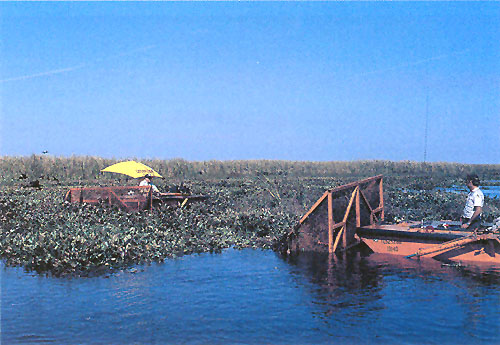
PHOTO 21: Aquatic “bulldozer” crowding water hyacinth for its collection by a harvester. Lake Okeechobee, Florida.
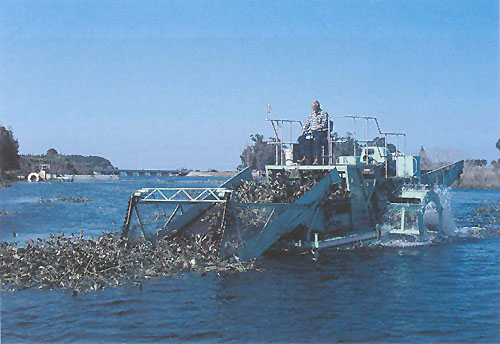
PHOTO 22: Harvester collecting water hyacinth. Lake Okeechobee, Florida.
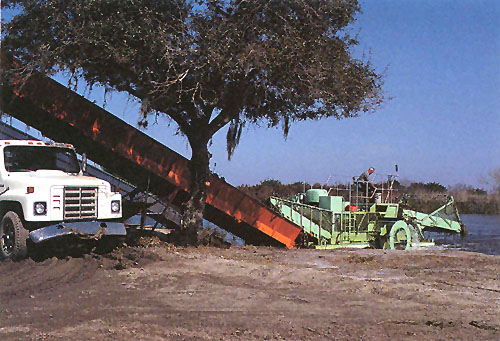
PHOTO 23: Loading of harvested water hyacinth into trucks for transfer into a dump. Lake Okeechobee, Florida.
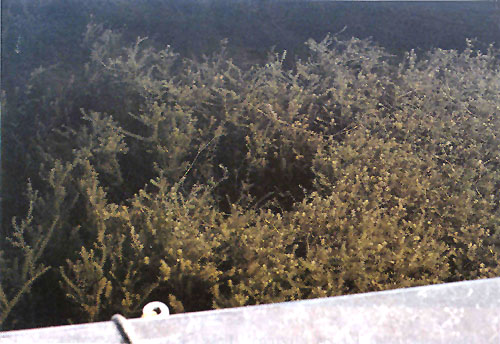
PHOTO 24: Hydrilla, Lake Okeechobee, Florida.
In its interior hydrilla mats contain little oxygen, raise surface water temperature, cause wide fluctuations in pH, and reduce the rate of decomposition by reducing oxygen and wave action. Once established, hydrilla eradication is difficult if not impossible. Like with water hyacinth, no control is initiated without considering impacts on fish and wildlife and their habitat. Most hydrilla control in Florida public waters is conducted using herbicides, as none of the five insect species or grass carp have been efficient to control this rapidly spreading plant. Mechanical control has proved too slow and costly. Using fluridone herbicide, 10 100 ha of surface-matted hydrilla on 10 930 ha Lake Istokpoga were controlled within two years, for US$ 1.8 million, which is US$ 90 ha-1, as against the estimate of US$ 1 250 needed if mechanical harvesters (200 of them) would work for two years to achieve the same result. Mechanical harvesters also remove substantial numbers of fish, reptiles, amphibians, and invertebrates in addition to plants. Schardt (1999) also points out that chemical control using fluridone, and occasionally endothall herbicides, retains viable fisheries and habitat. Sport fisheries have rebounded in lakes in which repeated large-scale herbicide treatments are being applied and native aquatic plants return.
For the impact of herbicide application on aquatic plants, and changes in the aquatic environment resulting from the subsequent plant decay, see Fig. 46.
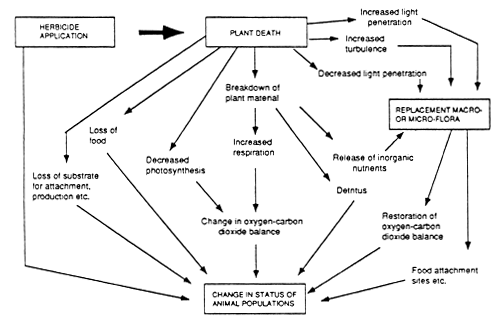
Fig. 46. Effects of aquatic weed control using herbicide and faunal changes likely to occur. (From Brooker and Edwards, 1975).
Removal of aquatic plants is done for various reasons, such as to clear the passage for ships, to speed up the flow of water through canals, or to prevent the blockage of intakes to pumps or to penstocks of hydropower stations. Mostly the physical removal of aquatic plants is temporary, as this is followed by a regrowth, or by invasion of plants from other areas of the water body. In temperate countries, such as in the UK, Russia and the USA, annual weed cutting programmes constitute a regular maintenance cost.
Excessive growths of aquatic macrophytes are common in the nutrient-rich and unshaded lowland streams and rivers of southern England. Dawson et al. (1991) studied what amount of aquatic invertebrates is removed with the cut weed and what consequences this may have on fish. In the River Frome, where weed cutting occurs twice a year, the biomass of invertebrates removed (largely chironomid and simuliid larvae) amounted to 2–3 t in fresh weight. In addition to destroying part of the invertebrate food supply available to fish, the weed cutting also renders many organisms vulnerable to fish predation. Dawson et al. (op.cit.) were unable to estimate the net effect of the reduction in food supply for fish as it would depend, among others, on the timing of weed cutting and invertebrate life histories. The authors found very few fish amongst weed that had been removed and this was in marked contrast to the use of floating harvesters in some lakes. Mechanical harvesting of the submersed weed Hydrilla verticillata in Orange Lake, Florida, entangled fish in the cut vegetation resulting in their disposal with the weeds on shore. Fish collected from the harvested weeds showed a density of 205 000 ± 35 000 fish ha-1, and standing crop of 460 ± 30 kg ha-1 (Haller et al., 1980); the estimated loss of fish to mechanical harvesting represented 32% of fish numbers and 18% of fish biomass. Fish most susceptible to mechanical removal with hydrilla were juvenile sportfish and smaller species. The monetary replacement value of the fish lost was estimated at over US$ 6 000 ha-1. Mechanical harvesting of Myriophyllum spicatum in Saratoga Lake, in the state of New York, was less harmful to fish stocks. The harvesting operation removed primarily bluegill sunfish (Lepomis macrochirus) and to a lesser degree, largemouth bass (Micropterus salmoides), yellow perch (Perca flavescens) and pumpkinseed sunfish (Lepomis gibbosus). In total, the harvesting of Myriophyllum removed about 3% of the total standing crop of juvenile fish (Mikol, 1985). In another lake in the USA, also overgrown with Myriophyllum spicatum, the use of a mechanical plant harvester, able to cut near the sediment surface, also had only a small incidental impact on fish, removing 36 fish ha-1, primarily small bluegill (Lepomis macrochirus) of less than 30 mm in length (Unmuth et al., 1998). But Nichols (1991) noted that the impact of harvesting of aquatic macrophytes is likely to vary tremendously between lakes, due to the differences in aquatic macrophytes, their densities, and different fish stocks. Well conducted experiments to quantify the impact of harvesting on fish are needed to understand the benefits and detriments of harvesting to fish populations.
Olson et al. (1998) studied the impact of mechanical harvesting of aquatic macrophytes on fish in four Minnesota lakes. Based on the results they concluded that changing the strategy of harvesting from clear-cutting the top metre of vegetation to selectively cutting deep channels throughout the lake may simultaneously improve the fishery and recreational value of a lake.
Lowering of the level of river water and speeding up water flow are secondary impacts of weed cutting on fish. The former may result in drying of attached eggs on the now exposed substrate, the latter making the flow rate too fast for the fry of some fish. The loss of invertebrates resulting from regular weed cutting in the River Frome was estimated by Dawson et al. (1991) to result in a loss of ca. 18% of fish production. The removal of their preferred feeding position will impact some fish species more than the other. Trout Salmo trutta, a mid-water feeder, will be more affected that the benthic feeder bullhead (Cottus gobio). A change in the traditional weed cutting to another method, which would leave, e.g. marginal strips or patches of weeds, could be more beneficial for fish and probably find support of recreational fishermen.
Mortensen (1977) found evidence that weed-cutting had detrimental effects on trout fry (Salmo trutta) in small Danish streams. Ostergaard (1999) reported that total cutting of aquatic macrophytes caused a decline in the trout populations, while a limited flow-channel cutting had a negligible effect in a small stream, and a positive effect in a large stream, in the latter case leading to a rise in the population of small (0+) fish. Total weed cutting in the large stream resulted in a decline in the population of large fish. In small streams total weed cutting impacted both the small and the large fish. A study on the Perry River (Swales, 1982), a tributary of the Severn River in England, found that mechanical removal by cutting of substantial part of aquatic plant stands disrupted fish feeding, reproduction and normal behaviour patterns. Cutting also removed considerable numbers of aquatic invertebrates on which some fish feed. Aquatic plants in the Perry River were directly utilised as food source by dace, and were an important spawning substrate for the phytophilous roach, perch and pike. Bankside vegetation contributes terrestrial insects when they fall into water. From an environmental point of view, 25% aquatic plant cover in English lowland rivers provides for conservation of aquatic invertebrates, fish and the plants themselves (Haslam, 1978).
In Ireland, a land-based ‘mowing bucket’, applied in the Grand and Royal Canals, cut the aquatic vegetation to canal bed level, thereby removing any substrate for colonisation by aquatic invertebrates. Nevertheless, macroinvertebrates increased rapidly following treatment and no adverse effect on dependent fish resulted (Monahan and Caffrey, 1996). The policy of removing obstructive vegetation from a central navigation channel, while preserving weeded marginal fringes, minimizes the impact of weed control operations on the macroinvertebrate fauna, and hence on the fish which depend on this food.
Results from weed cutting along one bank of a stream in Brittany (France) showed a negative impact on fish. One month after the plant removal (largely Ranunculus penicillatus), electrofishing surveys showed greater fish biomass and higher densities in vegetated areas. The density of Atlantic salmon parr (Salmo salar) was 30 ind. 100 m-2, as compared to only 15 ind. 100 m-2 in habitats without macrophytes. Removal of macrophytes has thus decreased the carrying capacity of the stream for age-0 salmon parr (Roussel et al., 1998).
In British canals the level of aquatic plant growth is closely related to boat trafic intensity. Where boat trafiic is heavy few plants are present and where little or no traffic is recorded an abundant flora prevails (Caffrey, 1993).
Water level fluctuation is widely used for aquatic plant management. Water can be raised or lowered, but drawdown is the most feasible and most often used fluctuation method (Nichols, 1991). Aquatic fauna may exhibit a dramatic change in species composition and biomass following drawdown and reflooding. While there may be an increase in some benthic macroinvertebrates, such as oligochaetes and chironomids, other macroinvertebrates may be adversely affected because of drying and freezing of exposed sediment. The impact on fish resulting from the changes in the benthic macroinvertebrates is poorly known. However, water level drawdown has been successfully used to increase fish standing crop, shift in species composition and to enhance spawning of some fish, such as bass (Micropterus spp) and crappie (Pomoxis spp) (Cooke et al., 1988).
Serafy et al. (1994), who studied the impact of the mechanical removal of hydrilla in the Potomac River, Maryland (USA) concluded that mechanical harvesting, when macrophyte beds are in short supply, may not be prudent as it may have a negative impact on fish species diversity and fish stocks.